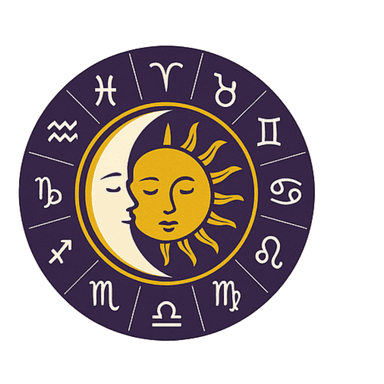Story of the Moon (Chandra) in Vedic Astrology

The Divine Birth of Chandra
The classical origin of Chandra is as mystical as his celestial glow. According to the Harivamsha Purana, Divine Sage Atri, by the force of his intense penance, willed for a radiant son. From his eyes burst forth a celestial radiance that spread across the ten directions. Unable to contain this brilliance, the directions released its effulgence, which settled on the earth as Soma. Lord Brahma placed this light in his chariot, circumambulated the world, and as he did, some of Chandra’s lustrous essence dripped down onto the earth, giving rise to all medicinal plants and healing herbs. This is why the Moon is not only associated with the mind but also with herbal medicine and rejuvenation.
A parallel myth describes Chandra as arising from the Samudra Manthan—the great churning of the cosmic ocean—by the gods and demons to obtain amrita (nectar of immortality). Along with other treasures, Chandra emerged, immediately revered for his radiant beauty and cooling influence.
Chandra and His 27 Wives: The Nakshatra Connection
One of the Moon’s most compelling stories is his marriage to the 27 daughters of Daksha Prajapati, who are the personifications of the 27 Nakshatras (lunar constellations). Chandra loved all his wives, but his devotion and affection were greatest for Rohini, the brightest and most beautiful among them.
Fascinated with Rohini, Chandra spent most nights with her, neglecting his other wives. Feeling slighted, the neglected sisters complained to their father, Daksha. After repeated but fruitless warnings, Daksha, in a fit of anger, cursed Chandra to lose his brilliance and slowly perish through consumption (tuberculosis). As Chandra began to waste away, darkness threatened the cosmos, plants withered, and tides faltered, so the gods intervened, appealing for a solution.
Shiva’s Boon and the Phases of the Moon
Desperate and fading, Chandra sought refuge with Lord Shiva, renowned for compassion and as ‘the conqueror over death’ (Mahamrityunjaya). At Prabhas Patan, Chandra crafted a Shiva Lingam and performed intense penance. Shiva, moved by his plea, placed him on his matted locks, granting him momentary immunity from the curse. Yet, the curse of Daksha could not be entirely nullified; Shiva ordained that Chandra would wax and wane, regaining and losing his radiance in a 29.5-day cycle—giving birth to the lunar phases.
In gratitude, Chandra adorns Shiva as an ornament, earning Shiva the title Chandrashekhara (the Moon-crested Lord), and blessing the world with both the waxing and waning light of the night sky.
The Moon and Mercury: Family, Rivalry, and Myth
Chandra’s fascinating story also extends to his relationship with Brihaspati (Guru/Jupiter), the preceptor of the gods. According to legend, Chandra was deeply attracted to Tara, the wife of Brihaspati. Their secret elopement enraged the gods and led to a cosmic standoff ended only when Tara was returned. By then, Tara was pregnant and gave birth to Budha (Mercury), one of the Navagrahas, who is therefore the son of Chandra and carries a complicated legacy—emotion (Moon) blended with intellect (Mercury).
The Moon in the Epics and Symbolic Lore
Chandra is lauded in the Vedas as effulgent, cool, and nurturing, the celestial Soma whose nectar vitalizes all living creatures. In the Mahabharata, Chandra is the progenitor of the Chandravanshi (Lunar Dynasty), which ultimately leads to the Pandavas and Krishna.
He is also closely tied to the making of amrita, the elixir of immortality, and is depicted as carrying a pot of the immortal soma. In some texts, Chandra is an auspicious guest of Vishnu, shining on Shiva’s head, and honored as a lamp that removes night’s darkness.
Chandra’s Astrological Significance
In Jyotish, Chandra is the “queen” among planets, ruling the sign Cancer (Karka), Monday (Somvar), and controlling the manas (mind), emotions, and subconscious. The Moon’s placement determines one’s Janma Rashi (Moon sign) and Nakshatra, profoundly shaping personality, memory, intuition, maternal bonds, and mental peace.
Chandra’s waxing and waning represent emotional tides, while his connection to the Nakshatras highlights different psychological qualities and destinies. The Moon governs the fluids within the body, mothers, travel, sleep, and fertility. Its strength blesses natives with empathy, creativity, adaptability, and receptive intelligence. An afflicted Moon brings mental unrest, mood swings, or lack of confidence, emphasizing the power of mind over life’s outcomes.
Spiritual Practices and Chandra’s Worship
Chandra is worshiped through Chandra Namaskar (Moon Salutation), Monday fasts, and recitation of “Om Chandraya Namah.” He is especially honored during Sharad Purnima, a festival seen as the full blossoming of lunar grace. In Ayurveda and Vastu, his soothing, nurturing influence is vital for healing and balancing fiery energies. Offerings of white flowers, rice, and milk are commonly made for lunar blessings and emotional balance.
Conclusion: Chandra’s Enduring Message
The mythic journeys of the Moon, from his divine birth to the waxing and waning phases, reflect the eternal rhythms of the psyche—growth, decline, and renewal. Chandra’s stories teach us about balance, devotion, consequence, and the ongoing dance between light and shadow in our inner lives.
In Vedic astrology, Chandra is more than a planet—he is a cosmic mind, guiding all beings through cycles of change and inviting us to embrace our emotional truth, intuition, and connection to life’s subtle mysteries.
